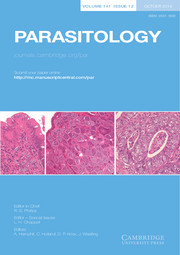Ver ítem
- xmlui.general.dspace_homeCentros e Institutos de InvestigaciónCICVyA. Centro de Investigación en Ciencias Veterinarias y AgronómicasInstituto de PatobiologíaArtículos científicosxmlui.ArtifactBrowser.ItemViewer.trail
- Inicio
- Centros e Institutos de Investigación
- CICVyA. Centro de Investigación en Ciencias Veterinarias y Agronómicas
- Instituto de Patobiología
- Artículos científicos
- Ver ítem
Vaccines against bovine babesiosis: where we are now and possible roads ahead
Resumen
Bovine babesiosis caused by the tick-transmitted haemoprotozoans Babesia bovis, Babesia bigemina and Babesia divergens commonly results in substantial cattle morbidity and mortality in vast world areas. Although existing live vaccines confer protection, they have considerable disadvantages. Therefore, particularly in countries where large numbers of cattle are at risk, important research is directed towards improved vaccination strategies. Here a
[ver mas...]
Bovine babesiosis caused by the tick-transmitted haemoprotozoans Babesia bovis, Babesia bigemina and Babesia divergens commonly results in substantial cattle morbidity and mortality in vast world areas. Although existing live vaccines confer protection, they have considerable disadvantages. Therefore, particularly in countries where large numbers of cattle are at risk, important research is directed towards improved vaccination strategies. Here a comprehensive overview of currently used live vaccines and of the status quo of experimental vaccine trials is presented. In addition, pertinent research fields potentially contributing to the development of novel non-live and/or live vaccines are discussed, including parasite antigens involved in host cell invasion and in pathogen-tick interactions, as well as the protective immunity against infection. The mining of available parasite genomes is continuously enlarging the array of potential vaccine candidates and, additionally, the recent development of a transfection tool for Babesia can significantly contribute to vaccine design. However, the complication and high cost of vaccination trials hinder Babesia vaccine research, and have so far seriously limited the systematic examination of antigen candidates and prevented an in-depth testing of formulations using different immunomodulators and antigen delivery systems.
[Cerrar]

Autor
Florin-Christensen, Mónica;
Suarez, Carlos Esteban;
Rodriguez, Anabel Elisa;
Flores, Daniela;
Schnittger, Leonhard;
Fuente
Parasitology 141 (12) : 1563-1592 (Octubre 2014)
Fecha
2014-10
Editorial
Cambridge University Press
ISSN
1469-8161
Formato
pdf
Tipo de documento
artículo
Palabras Claves
Derechos de acceso
Restringido
 Excepto donde se diga explicitamente, este item se publica bajo la siguiente descripción: Creative Commons Attribution-NonCommercial-ShareAlike 2.5 Unported (CC BY-NC-SA 2.5)
Excepto donde se diga explicitamente, este item se publica bajo la siguiente descripción: Creative Commons Attribution-NonCommercial-ShareAlike 2.5 Unported (CC BY-NC-SA 2.5)

